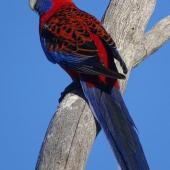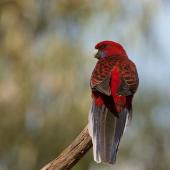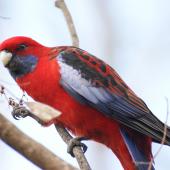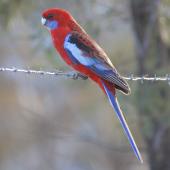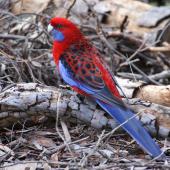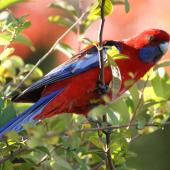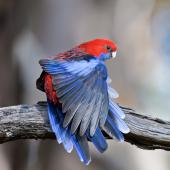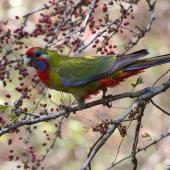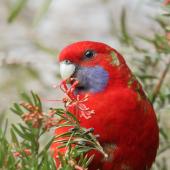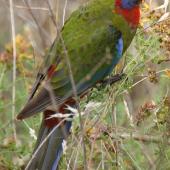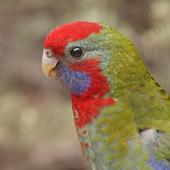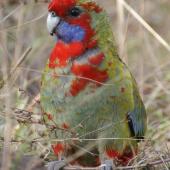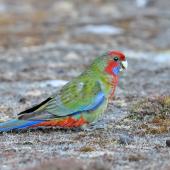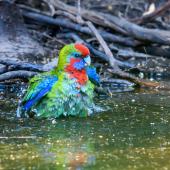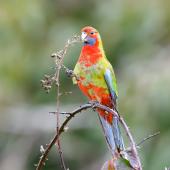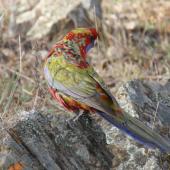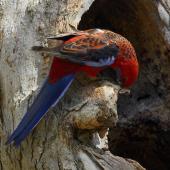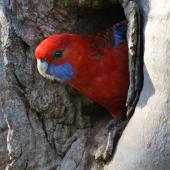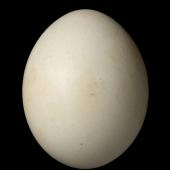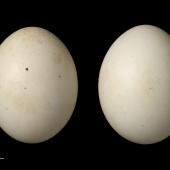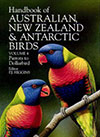Crimson rosella
Platycercus elegans (Gmelin, 1788)
Order: Psittaciformes
Family: Psittaculidae
Conservation status: Not evaluated
Other names: red parrot, crimson parrot, red lowry, mountain lowry
Geographical variation: New Zealand birds belonged to the crimson type – subspecies elegans, nigrescens or melanoptera
Crimson rosellas are brightly-coloured medium-sized parrots native to eastern and south-eastern Australia. Adults are instantly recognisable with their intense bright crimson and violet colouring. Small populations established in Dunedin and Wellington as a result of cage escapes. Both populations are believed to have died out, and the species was not included in the main section of 2022 Checklist of the birds of New Zealand, where it was listed in Appendix 2 as a failed introduction.
Identification
Crimson rosellas are similar in shape to eastern rosellas, with the same long tail common to all rosellas. They are slightly larger, however, and have very different plumage. Most of the body is rich crimson, including the head and chest. They have striking violet–blue cheek patches. The upper back is mottled with black, and the shoulders are light blue. The flight feathers are dark blue to black, and the tail is dark blue, lighter blue underneath, with small white tips on the outer feathers. Females are slightly duller than males, and may have a white under-wing bar. Juveniles are mainly bright olive-green, with a red forehead, breast and undertail, and blue cheek patches. Their flight is like that of the eastern rosella, direct and undulating.
Voice: frequent calls include the harsh brassy “klee klee klee” made when flying, “kwik-kweeek-kwik” piping notes often made when perched, and a soft chatter. These calls are are similar to those of eastern rosella, but differ in pitch.
Similar species: adults are unmistakable. Juveniles have some resemblance to eastern rosella and red-crowned parakeet, but note the blue cheek patches (white in eastern rosella, absent in red-crowned parakeet), and red on chest and under-tail (absent in red-crowned parakeet).
Distribution and habitat
The first wild population of crimson rosella established around Dunedin c.1910. This population reportedly hybridised with eastern rosella (which were released in the area at the same time), and apparently died out, or were absorbed into the eastern rosella population, in the 1960s. Another small population established in the western and northwestern suburbs of Wellington around 1963. Occasional sightings from elsewhere in the country over the years, including the Tararua Ranges in 1971, are most likely individual cage-escapees. In 1996 Heather & Robertson estimated the Wellington population at fewer than 20 individuals. It is likely that this species is now extinct in the wild in New Zealand. Also introduced to Norfolk Island, where it is common.
In their natural range, crimson rosellas use a variety of forested habitats from sea level to subalpine areas. They are most common in mature, wetter forests, but also inhabit open woodlands and urban parks, gardens and golf courses. The Wellington population was most frequently seen in the Botanical Gardens and other areas of parkland.
Population
Crimson rosellas are probably extinct in the wild in New Zealand.
Ecological and economic impacts
Crimson rosellas damage orchards in their native range. They have had considerable negative ecological impacts on Norfolk Island, where they compete with the endangered Norfolk Island green parrot for nest cavities.
Breeding
Crimson rosellas are cavity-nesters, using exisiting holes in tree trunks and branches to nest in, often very high off the ground. Pairs defend small areas around their chosen nest site during the breeding season. They form monogamous bonds, with pairs staying together over many breeding seasons. Females incubate the eggs (a clutch of 5 is typical) and brood the chicks, with both parents feeding the young. In their native range, the breeding season runs from September through to early February. Typically they raise just one brood per season.
Behaviour and ecology
The behaviour of the crimson rosella is similar to that of the eastern rosella. It is a noisy, gregarious species, frequently chasing one another. Much of their aggressive behaviour is ritualised, including the tail-wagging display accompanied by noisy chatter and beak clattering. Observations of crimson rosellas in New Zealand have typically been of pairs or individual birds. In Australia, adult birds are similarly found in their mated pairs, however juveniles and subadults will form slightly larger loose flocks (5-6 birds on average) in cooler months. Flocks of up to 100 birds have been recorded.
Food
Crimson rosellas mainly eat seeds, but they also consume a variety of other plant material including fruit, nectar, shoots, buds, and leaves. Some invertebrates are taken, particularly during the breeding season. They sometimes feed on the ground, but more often in trees and shrubs, typically foraging in pairs or small flocks. Crimson rosellas join mixed flocks with other parrot species in their native range, and some come to feeders in urban areas.
Weblinks
http://en.wikipedia.org/wiki/Crimson_Rosella
References
Hamel, J. 1970. Hybridization of eastern and crimson rosellas in Otago. Notornis 17: 126-129.
Heather, B.D.; Robertson, H.A. 1996. The field guide to the birds of New Zealand. Viking, Auckland.
Hicks, J. Preece, M. 1991. Green parrot; 1991 Recovery Plan. Unpublished report. Australian National Parks and Wildlife Service, Canberra.
Higgins, P.J. (ed.) 1999. Handbook of Australian, New Zealand and Antarctic birds. Vol. 4, parrots to dollarbird. Oxford University Press, Melbourne.
Krebs, E.A. 1998. Breeding biology of crimson rosellas (Platycercus elegans) on Black Mountain, Australian Capital Territory. Australian Journal of Zoology 46: 119-136.
Macdonald, J. D. 1973. Birds of Australia, Reed, Sydney.
Pizzey, G. 1980. A field guide to the birds of Australia. Princeton University Press, Princeton, N.J.
Pizzey, G.; Knight, F. 1999. The field guide to the birds of Australia. Harper Collins Publishers, Australia.
Recommended citation
Galbraith, J.A. 2013 [updated 2022]. Crimson rosella. In Miskelly, C.M. (ed.) New Zealand Birds Online. www.nzbirdsonline.org.nz
Crimson rosella
- Breeding season
-
- Jul
- Aug
- Sep
- Oct
- Nov
- Dec
- Jan
- Feb
- Mar
- Apr
- May
- Jun
- Egg laying dates
-
- Jul
- Aug
- Sep
- Oct
- Nov
- Dec
- Jan
- Feb
- Mar
- Apr
- May
- Jun





